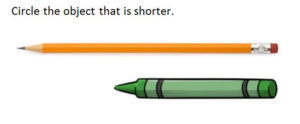MAFS.K.MD.1.2: Directly compare two objects with a measurable attribute in common, to see which object has “more of”/“less of” the attribute, and describe the difference. For example, directly compare the heights of two children and describe one child as taller/shorter.
Cognitive Complexity Level: 1-Recall
[divider] [/divider] Students are able to…
- Use precise vocabulary such as taller, longer, shorter, heavier, lighter, holds more/less
- Compare two objects by height, length, weight, and capacity
- Align endpoints of two objects to determine which is shorter or longer/taller
[divider] [/divider] Students are able to…because teachers:
- Model precise vocabulary such as taller, longer, shorter, heavier, lighter, holds more/less
- Provide opportunities to observe, handle, and discuss various objects in real-world contexts
- Ask students to find multiple objects that are longer, taller, heavier, etc. than another.
[divider] [/divider] Questions to ask students:
- Which object is longer? How do you know?
- Why is it important that both objects begin at the same place?
- What items can you find that are heavier than the _____?
- If an object is taller, is it always heavier?
- How could you describe these towers to me?
- What does it mean to be shorter?
- How do you measure the height of a picture of an object compared to the real object?
[divider] [/divider] Additional Resources:
Additional in depth content knowledge
[divider] [/divider] Sample Formative Assessment Tasks:
[divider] [/divider] Resources/Tasks to Support Your Child at Home:
- Have your child trace their foot with chalk on the sidewalk. Then trace a friend’s foot. Have the child compare, which foot is longer? Which foot is shorter?
- Have your child compare their height with your height. Who is taller? Who is shorter?
- Find household items of different weights to have your child compare the weights using the language heavier or lighter.
- Use different sized containers, including different heights and widths. Pour water into the containers, tracking how much it takes to determine which containers hold more and which containers hold less.
